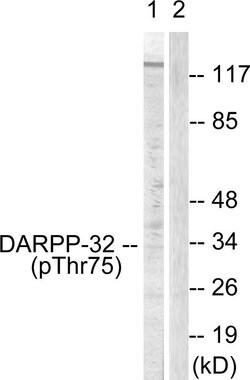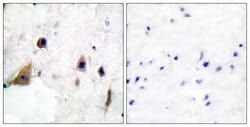Promotional price valid on web orders only. Your contract pricing may differ. Interested in signing up for a dedicated account number?
Learn More
Learn More
Phospho-DARPP-32 (Thr75) Polyclonal Antibody, Invitrogen™
Rabbit Polyclonal Antibody
Supplier: Thermo Scientific PA538065
Description
Dopaminergic signaling pathways, which are essential for multiple brain functions, are abnormal in several neurological disorders, such as schizophrenia, Parkinson′s disease and drug abuse. DARPP-32 (for dopamine and adenosine 3′,5′-monophosphate-regulated phosphoprotein of 32 kDa) is abundant in neurons that receive dopaminergic input. Activation of PKA and the consequent phosphorylation of DARPP-32 on threonine occurs in response to dopamine acting upon D1-like receptors. Dopamine interaction with D2-like receptors results in the inhibition of PKA activation, the activation of protein phosphatase 2B and the consequent dephosphorylation of DARPP-32. Neurotransmitters other than dopamine may also be able to stimulate the phosphorylation or dephosphorylation of DARPP-32. Phosphorylated DARPP-32 is a potent inhibitor of PP-1.
Specifications
| Phospho-DARPP-32 (Thr75) | |
| Polyclonal | |
| Unconjugated | |
| PPP1R1B | |
| Dopamine- and cAMP-regulated neuronal phosphoprotein, IPPD, Neuronal phosphoprotein DARPP-32, PPP1R1B | |
| Rabbit | |
| Antigen affinity chromatography | |
| RUO | |
| 19049, 360616, 84152 | |
| -20°C | |
| Liquid |
| Immunohistochemistry (Paraffin), Western Blot | |
| 1 mg/mL | |
| Dulbecco′s PBS with 150mM NaCl, 50% glycerol and 0.02% sodium azide; pH 7.4 | |
| Q9UD71, Q60829, Q6J4I0 | |
| PPP1R1B | |
| A synthetic phosphopeptide derived from human DARPP-32 around the phosphorylation site of Thr75 (A-Y-TP-P-P) | |
| 100 μg | |
| Primary | |
| Human, Mouse, Non-human Primate, Rat | |
| Antibody | |
| IgG |
Safety and Handling
WARNING: Cancer - www.P65Warnings.ca.gov
Product Content Correction
Your input is important to us. Please complete this form to provide feedback related to the content on this product.
Product Title
Spot an opportunity for improvement?Share a Content Correction

